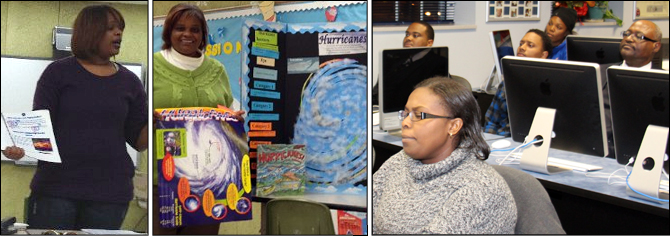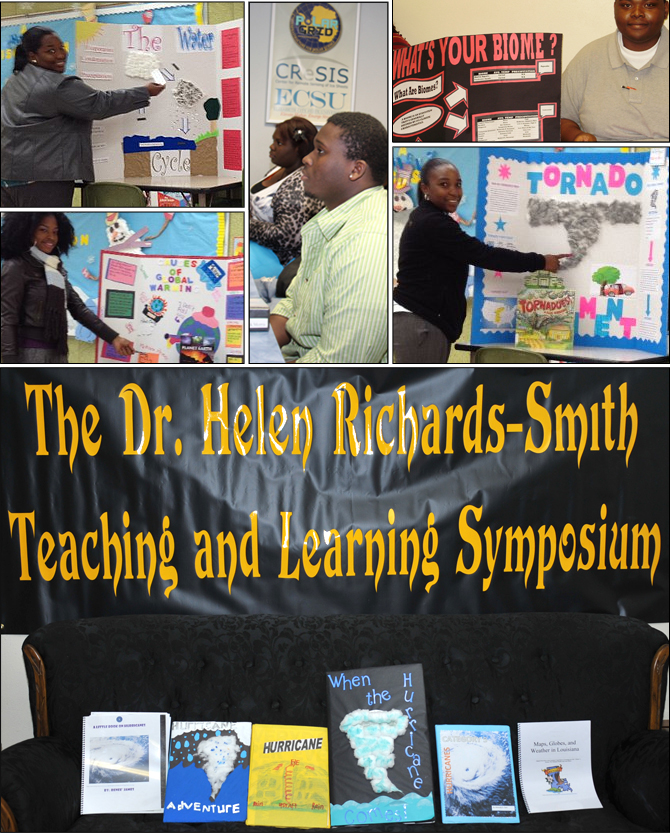November 15, 2012
Elizabeth City State University
On November 15, 2012, students in the Center of Excellence in Remote Sensing Education and Research (CERSER) program took part in a Polycom conference with students at Grambling State University as part of the American Education Week Teaching and Learning Symposium. This conference was sponsored by the NASA Innovations in Climate Education (NICE) and allowed CERSER students to observe various activities and projects that the teacher candidates and advanced candidates have completed to incorporate the NASA NICE Climate Education Concepts into the Teacher Education component.
The project at Grambling State University is headed by Dr. Loretta Jaggers and served to document activities that students in the Curriculum and Instruction Department (College of Education) have implemented while serving as a participant in the Elizabeth City State University (ECSU) and the University of New Hampshire (UNH) NASA Climate Education Grant Program. Dr. Linda Hayden, PI of the NASA NICE project is the director of the CERSER program at ECSU.
The full program of the event can be found here and more photos of the interactions with students can be found here.
Below are descriptions of the students work to bring climate education to the classroom
Mrs. Shakeydra J. Hill - Climate Change and Hurricanes
Mrs. Hill wrote a book steming from a NASA NICE conference. She used the book in the classroom to correct reading difficulties. The book implemented vocabulary and illustrations about climate change and hurricanes. She also utilized a vocabulary strategy through use of the internet.
Ms. Yu Feng Huang-Hurricane Book
Ms. Huang developed a book on hurricanes to assist students in understanding vocabularyin understanding vocabulary as it relates to hurricanes. She also included comprehension activities that focused on sequencing of events and cause-effects relationships in connection to the development of hurricanes. Finally, she included activities that integrated Math Geography, and other Reading/Literacy skills.
Ms. Kaleisha Lewis-The Cause of Tornadoes
Ms. Lewis presented her project titled "Cause of Tornadoes". This project provided descriptions about tornados and incorporated a technology infused activity entitled, “Name that Picture”. This project included a display board to help second graders visualize what a tornado is as well as how it forms. The students watched videos about tornadoes to help visual and auditory learners. She also created tornados with two bottles to aid kinesthetic learners. The project provided descriptions about tornadoes and incorporated a technology aid titled "Name that Picture". Ms. Lewis then created a quiz to assess the student’s comprehension of the lesson presented.
Ms. Deanna Ellsworth-Hurricane Display Board
Ms. Ellsworth focused on hurricanes and how they developed. She created a project board that illustrated how a hurricane is formed. Ms. Ellsworth asked the students to read a story regarding hurricanes. After reading and discussing the story, the students participated in a comprehension activity that included discussions about the main idea, details and the specific vocabulary that relates to hurricanes.
Dr. Elaine Foster – Illustrations from Children’s Books
- Mr.Jonathan Barris-Children’s Literature Story Aprons(Climate Change Concept)
- Ms. La Crystal Thomas-Children’s Literature Story Aprons (Climate Change Concept)
- Ms. Kellie Love-Children’s Literature Story Apron (Climate Change Concept)
- Ms. Selea Hayes- Children’s Literature Story Apron (Climate Change Concept)
Ms. Selea Hayes-Global Warming Display Board
Ms. Hayes created 3d global warming poster and used illustrations to relate to the kids that the earth is sick and how we as a whole can make it better.
Mr. Johnathan Washington - Biology Board
Mr. Washington focused on defining Biomes to students. He created a display board covering the different types of biomes and their characteristics. |





 ED 304: Children’s Literature
ED 304: Children’s Literature